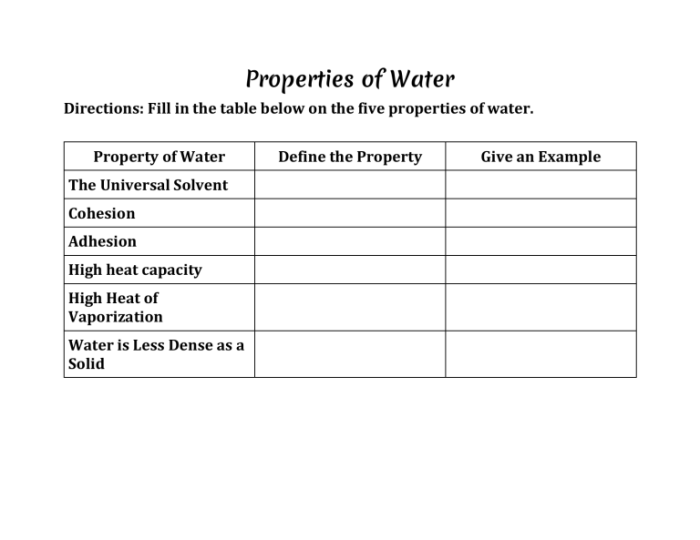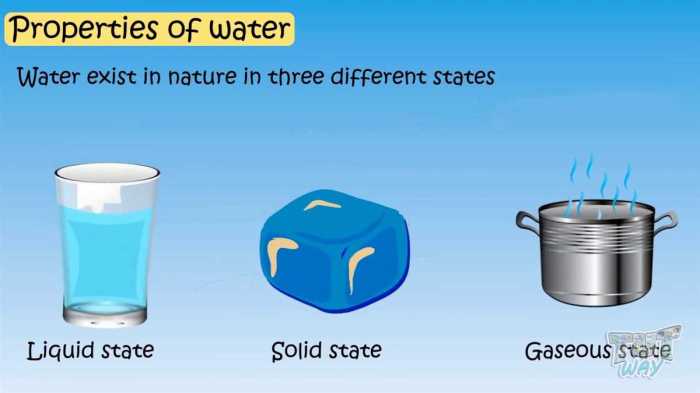Embarking on an in-depth exploration of the properties of water webquest answers, this comprehensive guide delves into the unique physical, chemical, biological, and environmental characteristics of this life-sustaining substance, unraveling its profound impact on our planet and its inhabitants.
From its remarkable surface tension to its crucial role in biological processes, water’s properties shape the very fabric of our world. This webquest delves into the intricate details of these properties, providing a comprehensive understanding of water’s significance in various scientific disciplines.
Physical Properties of Water

Water possesses distinctive physical properties that distinguish it from other liquids. Its high surface tension, specific heat capacity, and density are attributed to the unique arrangement of its molecules and the presence of hydrogen bonding.
Hydrogen bonding occurs between the partially positive hydrogen atoms and partially negative oxygen atoms in water molecules. This intermolecular force creates a strong cohesive network that gives water its high surface tension, enabling it to form droplets and resist breaking.
The specific heat capacity of water, or the amount of heat required to raise the temperature of a unit mass by one degree Celsius, is unusually high. This property allows water to absorb and release large amounts of heat without undergoing significant temperature changes.
This makes water an effective coolant and heat reservoir.
Water is also denser than most other liquids at room temperature. This density is due to the close packing of water molecules held together by hydrogen bonds. The density of water plays a crucial role in its ability to support aquatic life, as it allows organisms to float and move through the water column.
| Property | Water | Ethanol | Mercury |
|---|---|---|---|
| Surface tension (N/m) | 0.073 | 0.022 | 0.486 |
| Specific heat capacity (J/g°C) | 4.19 | 2.45 | 0.14 |
| Density (g/cm3) | 1.00 | 0.79 | 13.6 |
Chemical Properties of Water: Properties Of Water Webquest Answers

Water is a versatile chemical compound with distinct properties that contribute to its role in various chemical reactions and biological processes. Its polarity, ability to dissolve substances, and reactivity make it an essential component of life on Earth.
Water is a polar molecule, meaning it has a slightly positive end and a slightly negative end. This polarity enables water to dissolve ionic compounds and polar molecules. The polarity of water is also responsible for its high dielectric constant, which allows it to support the formation and dissociation of ions in solution.
Water’s ability to dissolve a wide range of substances makes it a universal solvent. This property is crucial for biological processes, as it allows nutrients, waste products, and other molecules to be transported throughout organisms.
Water also participates in various chemical reactions. It can act as a reactant, a product, or a catalyst. For example, water is a reactant in photosynthesis, where it is split into hydrogen and oxygen. It is also a product in respiration, where it is formed as a byproduct of the breakdown of glucose.
The pH scale measures the acidity or alkalinity of a solution. Water has a neutral pH of 7.0, indicating that it is neither acidic nor basic. The pH of water is crucial for aquatic ecosystems, as it affects the availability of nutrients and the survival of organisms.
Biological Importance of Water

Water is the elixir of life, constituting over 70% of the human body and playing a vital role in countless biological processes. Its unique properties enable it to support and sustain life on Earth.
Water is involved in cellular processes, including metabolism, transport of nutrients and waste, and temperature regulation. It provides the medium for enzymatic reactions and facilitates the movement of molecules across cell membranes.
Water’s high specific heat capacity allows it to absorb and release large amounts of heat without significant temperature changes. This property helps maintain a stable body temperature in organisms, protecting them from extreme heat or cold.
Some organisms have adapted to survive in extreme water conditions. For instance, desert plants have developed water-storing tissues and efficient water-use mechanisms to withstand arid environments. Conversely, aquatic organisms have evolved gills or other specialized structures to extract oxygen from water.
Environmental Significance of Water
Water is an indispensable component of the Earth’s environment, playing a crucial role in the water cycle, climate regulation, and habitat provision.
The water cycle describes the continuous movement of water between the atmosphere, land, and oceans. Water evaporates from the oceans and land, condenses to form clouds, and precipitates back to Earth as rain or snow. This cycle sustains ecosystems and provides freshwater for human consumption and agriculture.
Water bodies, such as oceans, lakes, and rivers, regulate the Earth’s climate by absorbing and releasing heat. They act as heat sinks, mitigating temperature extremes and influencing regional and global climate patterns.
Water also provides habitats for a vast array of aquatic organisms. Wetlands, estuaries, and coral reefs are hotspots of biodiversity, supporting diverse ecosystems and providing essential ecosystem services.
Threats to water quality and availability include pollution, climate change, and overconsumption. Industrial waste, agricultural runoff, and sewage discharge can contaminate water sources, posing risks to human health and aquatic ecosystems.
Climate change is also impacting water resources. Rising temperatures lead to increased evaporation and altered precipitation patterns, resulting in droughts in some regions and floods in others. Overconsumption of water, particularly in agriculture and industry, can also deplete water resources and lead to water scarcity.
FAQ Overview
What is the significance of hydrogen bonding in determining water’s properties?
Hydrogen bonding is a crucial factor in shaping water’s unique properties. The strong electrostatic attraction between hydrogen and oxygen atoms in water molecules results in the formation of hydrogen bonds, which influence its high surface tension, high specific heat capacity, and density.
How does water’s polarity contribute to its ability to dissolve substances?
Water’s polarity, arising from the uneven distribution of electrons within its molecule, enables it to act as a universal solvent. Polar molecules and ionic compounds readily dissolve in water due to electrostatic interactions between their charged regions and the polar water molecules.
What is the role of water in biological systems?
Water is essential for life as it constitutes approximately 70% of the human body and plays a vital role in cellular processes, nutrient transport, temperature regulation, and waste removal. Its unique properties, such as high specific heat capacity and surface tension, contribute to maintaining a stable internal environment within living organisms.